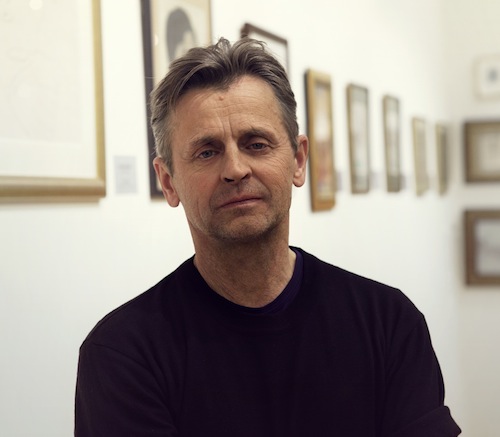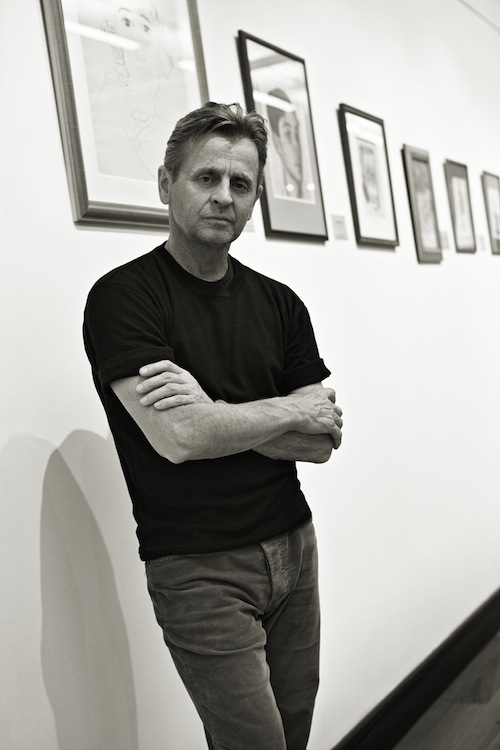
Mikhail Baryshnikov at ABA Gallery, 2012. Photograph by Graham Lott.
“It is a little bit like allowing the public to your bedroom,” Mikhail Baryshnikov says of the experience of exhibiting his art collection, more than a hundred works representing nearly four decades of buying art. We travel from the St. Petersburg fin-de-siècle, through the Russian avant-garde, to the Soviet non-conformist movement, while taking a look at some of the major figures in ballet over the past century. Showing at ABA Gallery on East 17th Street, Manhattan, through December 15, The Art I’ve Lived With: Works from the Collection of Mikhail Baryshnikov is an eclectic, individualized, and personal exhibition, down to the installation decisions. It is meant, more than anything, Baryshnikov says, as “a tribute to the artists involved.” It was the director of the Pushkin Museum in Moscow, Irina Antonova, who encouraged the exhibition years ago, an idea Baryshnikov would eventually agree to at the follow-up suggestion of his friend, gallery owner Anatol Bekkerman, a specialist in nineteenth and early twentieth-century Russian art.
Baryshnikov himself is charmingly humble about his role as collector, in conversation he self-identified and then called it a “slip.” He’s quick to point out that he is neither a shrewd buyer nor an art scholar, these are essentially heart-based purchases, dependent on what he could afford at the time. He began in his late twenties, in Paris, 1975, with the selection of a Jean Cocteau drawing and a Christian Bérard design for George Balanchine’s Mozartiana, and he describes the exhilaration of carrying them back to the hotel and unwrapping them and staring, unable to believe that he now owned works by names he’d studied and admired in school.
Over the years the collection grew, supplemented by many gifts: frenetically penned large-winged people-insects and birds by Merce Cunningham; an inscribed design sketch of three different types of footwear by David Salle in 1986; Joseph Brodsky’s drawings of unshaven sailors standing around, Shore Leave (nd); two significant and beautiful late 1950s abstracts by the persecuted founder of Russian Expressionism, Anatoly Zverev. These are among the works that Baryshnikov acquired and often traveled with, needing to keep with him images of dance and theater, of the world, as he said, where he “feels most comfortable.”

Valentine Gross. Nijinsky in “Le Spectre de la Rose,” nd. Collection of Mikhail Baryshnikov. Image courtesy ABA Gallery.
Although the artworks are stylistically and tonally diverse, the interconnected artists and subjects reveal a strong presence of the Ballets Russes. One of the most explosive artistic collaborations of the twentieth century, the Ballets Russes sought to revolutionize the old art forms, integrating modern art and design, Russian folklore, and innovative choreography inspired by post-Impressionism and Cubism into the performances, so that every element of the ballet: libretto, sets, costumes, choreography, score, reached for a new height of artistic experimentation and synthesis. Founded by the Russian arts impresario Serge Diaghilev, the Ballets Russes premiered in Paris in 1909, with legendary dancers Anna Pavlova, Vaslav Nijinsky, and Michel Fokine, and grew to include collaborations with major figures of the Russian and European avant-garde: artists Pablo Picasso, Henri Matisse, Pavel Tchelitchew, Giorgio de Chirico, Natalia Goncharova; writers Jean Cocteau and Guillaume Apollinaire, as well as composers Erik Satie and Claude Debussy, and choreographer George Balanchine. To understand the impact this level of innovation had on the public: at the highly fashionable May 1913 Paris premier of Le Sacre du Printemps (The Rite of Spring), designed by Nicholas Roerich, with choreography by Nijinsky, and the now well-known score by Igor Stravinsky, a riot broke out, shouting and fist-fights, forcing Stravinsky to flee and leaving Nijinsky to climb up on a chair, hollering out the counts for the dancers above the roaring crowd.
Here, in a portrait by Valentine Gross, Nijinsky in “Le Spectre de la Rose” (nd), the legendary dancer and choreographer emerges gracefully from a blue cloud of movement—an unexpected gift that Baryshnikov received from an elderly stranger after one of his own performances. The portrait captures Jean Cocteau’s description of what it was to see Nijinsky on stage, “his figure lengthened…his hands became the fluttering leaves of his gestures, and as for his face, it was radiant.”
Several of Cocteau’s wry drawings punctuate the collection, adding to his anecdotes of his time with the Ballets Russes. In The Difficulty of Being, Cocteau tells the story of a dinner with Nijinsky, during which the dancer kept rolling his head around as if he had a sore neck. This was shortly before the opening of L’après-midi d’un faune (The Afternoon of a Faun) (1912), in which Nijinsky was playing the title role, and so Diaghilev and the designer Léon Bakst became alarmed and asked him about it. He refused to answer. Later it came out that he was training his neck to be able to support the weight of the horns. In the drawing Cocteau made years later, in 1957, long after the onset of Nijinsky’s schizophrenia, and his retirement from the stage, he is shown as the faun, with an impossibly long, graceful gazelle neck, a fierce look of concentration, and two tiny little horns. There are drawings of Diaghilev here, too, with the monocle and large head that always made him appear to be wearing “the smallest hat in the world,” as Cocteau said.

Sergei Sudeikin. Costume Design for Jack-in-the-Box, nd. Collection of Mikhail Baryshnikov. Image courtesy ABA Gallery.
Also remarkable are several paintings by Sergei Sudeikin—vibrant, richly imagined work employing theatricality, costume, and elements of the grotesque. Sudeikin, once kicked out of the Moscow School of Painting for the “indecent content” in his paintings, went on to become part of the St. Petersburg World of Art group and a stage artist for the Ballets Russes. The theater is also evident in Natalia Goncharova’s arresting street scene, the sudden intrusion of color in the heavily powdered face of a passing woman who makes eye contact with us, her violently rouged cheek echoing the red in her hat.
The collection includes a number of working sketches from the celebrated Ballets Russes costume designers Alexandre Benois and Léon Bakst, who created many of the exotic, ornate designs for the “new ballet”—the collision of colors and creative re-interpretations of historic periods, ancient Greece, eighteenth-century France, and Arcadian themes—that audiences went crazy for. These finely detailed, annotated, colored sketches, which include multiple vantage points and instructions for the tailor, and in some cases swatches of material, are hung salon style, as Baryshnikov notes, “like at Gertrude Stein’s, in the old photographs.” This is also how they are hung in his study at home—everything arranged together with congenial familiarity.
It is Baryshnikov’s intimate and nuanced understanding of the works’ subject that far exceeds another collector’s. He has danced in Fokine’s style in the tremendously challenging role of Nijinsky’s in Le Spectre de la Rose from 1911, The Rite of Spring (1913), Petrushka (1911), Sleeping Beauty (1890), Giselle (1841). This is an artistic lineage that has been embodied, reinterpreted, and brought through to the present. At ABA Gallery, until Saturday, you have the rare opportunity to see the multiple sources of inspiration for one of the most iconic dancers of our own age, and to understand the way in which art can be both a spontaneous emergence of talent, and the result of years of creative conversations with the past.

Mikhail Baryshnikov at ABA Gallery, 2012. Photograph by Graham Lott.
The Art I’ve Lived With: Works from the Collection of Mikhail Baryshnikov is on view through December 15, at ABA Gallery, 7 East 17th Street, New York.
I welcome thoughts, ideas, show announcements. Please email me at alchemyofinspiration(at)gmail.com.



